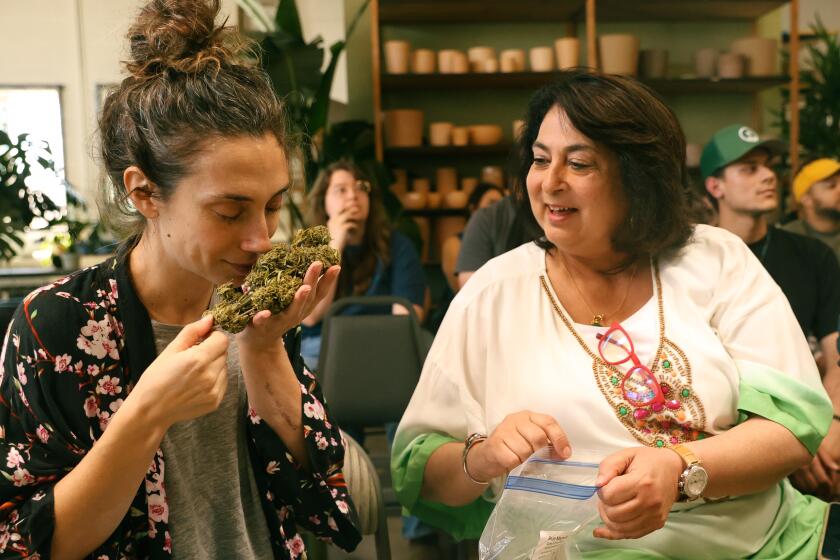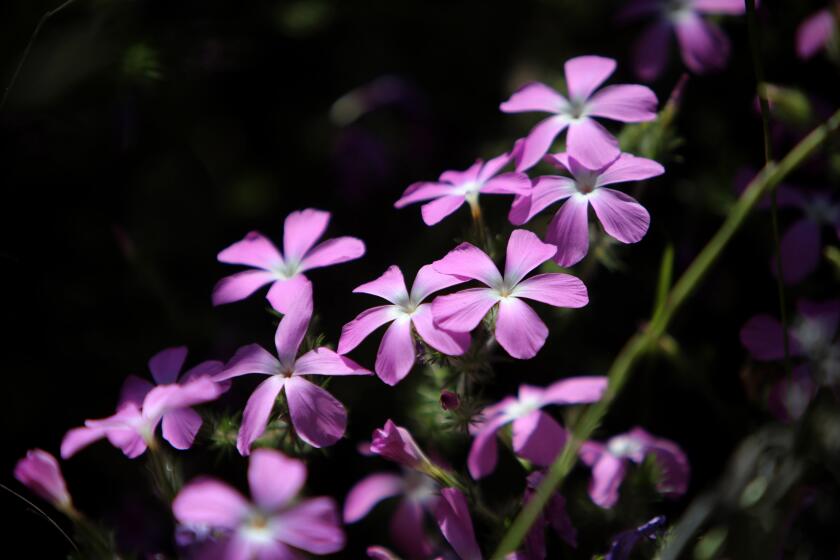How to Get Tasty Basil Into Mint Condition
Few herbs tantalize the taste buds or jazz up the garden like basil.
A member of the mint family, basil is an annual herb that thrives in hot weather. Plant this prolific herb and you can enjoy fresh basil with its spicy, licorice-flavored leaves for months.
Not only does basil provide you with a tasty edible crop, it is also a nice plant for summer landscaping, said Fullerton gardener Joyce Smith, a volunteer for the Friends of the Fullerton Arboretum Potters, who has grown basil and tomatoes for the annual Green Scene to be held at the Arboretum on April 26 and 27.
“Many basil leaves are bright green and glossy, and there are beautiful purple-foliage varieties,” she said.
Basil also has flower stalks that come in shades of white, purple and pink. It is a fast-growing plant that usually reaches about 2 1/2 feet tall and spreads a foot and a half.
Once thought of as just a herb for Italian dishes, basil has become more popular in recent years.
“Pesto used to be the reason why people grew basil, but now we’ve discovered that it can be added to almost anything,” Smith said. “Not only is it a great addition to tomato dishes, it also tastes good on fish, chicken, vegetables and fruit and can be eaten raw in salads. Many of the scented basils also make a nice tea, and they can be dried for potpourri.”
There are many more kinds of basils besides the traditional smooth-leafed variety. Some have ruffled leaves; others can have big or small leaves. There are even basils with striking red leaves. A number of scented basils come in a variety of flavors, including cinnamon, lemon and anise. And there are miniature basils that do well in containers.
Though it is one of the world’s more popular herbs, basil wasn’t always held in such high esteem, said Anaheim gardener Dennis Glowniak of the California Organic Gardening Club, who is this year’s Green Scene coordinator and a basil grower.
“Basil has had a mixed past,” he said. “The Greeks and early Europeans thought that it was poisonous because scorpions liked to live in the plants.”
In later years, Europeans had a change of heart when the Italians discovered basil to be a culinary delight. The herb then got a reputation as a sign of courtship and love, and in England it was even considered an aphrodisiac.
While basil enjoyed a checkered past in Europe, in Thailand the plant has always been revered. Basil grows wild there and is used in many of their national dishes.
*
To plant basil and enjoy a prolific crop, keep the following in mind:
* Wait until the soil and nighttime temperatures are 55 degrees or above to plant basil outdoors. This usually doesn’t occur until mid-May. Before this time, germinate seeds indoors. Place the pots in a warm location such as a sunny windowsill.
* Choose a location with full sun. Basil planted in shade or part sun will become leggy and not produce very many leaves per stem.
* Basil likes a rich, well-draining soil. Before planting, amend the planting site with homemade compost or bagged redwood compost at a rate of 50% compost and 50% existing soil.
* Basil plants found in the nursery are often grown in clusters. When planting transplants, carefully separate plants so you have one single plant in each planting hole. This will promote strong, healthy growth.
* If you plant basil seed, thin to two inches apart when they reach 2 to 3 inches high.
* To ensure a steady supply of basil, sow seeds or plant new transplants every two to three weeks.
* Don’t pamper basil with too much fertilizer. Compost provides nutrients, and you can feed basil at the beginning of the growing season with an organic, balanced fertilizer, which will slowly feed the plant over the growing season.
* Keep basil well-watered, but never soggy, as it is susceptible to root rot. Generally, basil should be watered deeply about once a week. Never overhead water, as basil is susceptible to leaf diseases caused by too much moisture.
* Begin harvesting basil when the plants are about 6 inches high and have six to eight pairs of leaves. Cut each stem back to two to four remaining leaves, which will cause the plant to grow and produce more leaves.
* Prolong your basil plant’s life by not letting it start flowering, which will put it in a seed-producing mode. Once it starts producing flowers, it won’t stop, Glowniak said.
“To prevent flowering, cut each stem back to two to four leaves per stem before the stems have more than eight pairs of leaves,” he said. Each stem you cut back will form two to four new, harvestable branches in three to four weeks.
* Basil grows well in containers. Laguna Beach gardener Caroline Hoover, who is president of the Orange County Herb Society, suggests using plastic pots when growing basil because they don’t dry out as quickly as other types.
Plant in a container that is at least 5 inches in diameter and 7 inches deep. Three basil plants will do well in a half barrel. One mini basil will fill a small pot.
Use a high-quality potting soil or make your own mix. Hoover mixes planting mix with a small amount of packaged composted animal manure and garden soil. Water containers before they dry out and fertilize twice during the growing season with an all-purpose liquid fertilizer.
* Harvest basil for cooking right before you need it, which will help preserve the essential oils. If you don’t use all of the basil, the remaining leaves can be stored in damp paper towels in the vegetable crisper for three days.
* Preserve excess basil for cooler months by freezing it chopped up and mixed with olive oil or water in ice-cube trays.
* Use purple-leafed varieties to make herbal vinegars. Submerge leaves in white wine vinegar in a clear bottle that has a tight cork lid. The vinegar will become an attractive purple color. Store in a cool, dark place.
* Dry basil in grocery bags until it is crisp and then store it uncrushed in airtight bottles in a cool, dark place, or use in potpourri. Basil can also be dried in the oven on low about 100 degrees.
The Green Scene Garden Show will be held at the Fullerton Arboretum, 1900 Associated Road, Fullerton from 9 a.m. to 4 p.m. April 26 and 10 a.m. to 4 p.m. April 27. Admission is $5 for adults; children are free. For information, call (714) 773- 3404.



